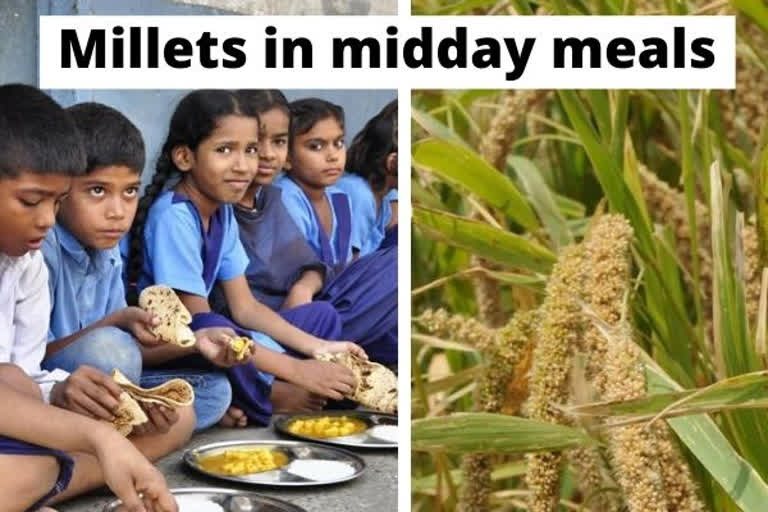Hyderabad: About 2.5 decades ago, the ‘Midday Meal’ scheme had come into existence to counter the hunger which stalls the kids from getting educated. It is unfortunate that even today, in many states there are huge lapses in the implementation of the same.
Initially designated as 'nutritional support for elementary education', each student should be provided with 300 calories and 8-12 grams of protein for at least two hundred days a year.
Around 450 calories and 12 grams of protein for those in basic classes; 700 calories, 20 for elementary students. The scheme has been revamped to provide the needed grams of protein. Although the Supreme Court has made it clear that lunch is a legal right for children of school-going kids, there have been numerous instances of statehood where this spirit is being lost when it comes to the actual implementation of the same.
A ten-year-old central government study itself confirmed that half a meal is served to children in around seventeen states. The comptroller and auditor general report has time and again proved that the quality of the meal is poor, by monitoring deficiencies and inspections.
Though governments claim to have budgeted and spent around thousand lakhs of rupees on around 9 crore students across more than 11 lakhs of schools, incidents like one litre of milk, adulterated with water has been fed to 81 kids in UP is unfortunate.
Around three-quarters of children across the country are suffering from malnutrition. As per the National Family Health Survey - 38 per cent of the population is underweight, as a balanced diet seems to be unattainable.
A recent study showed that children can have at least 50% of high growth rate if they are provided with a protein-rich diet; rich by replacing rice and wheat with millets such as fox millet, kodo millet, lentils etc., at lunch – thus stating that these days, best alternate diet is available for growing kids in the forms of millets and cereals.
Are we providing the right nutrition?
A joint study of ICRISAT (International Crops Research Institute for the Semi-Arid Tropics) and 'Akshaya Patra' illustrates how a cereal-rich diet can make children feel much better. Analysis that abundance of nutrients is seen in people who eat cereals such as Idli, Kichidi and Upma prepared from millets is more when compared to the students who ate sambar-rice. This study emphasizes the need for corrective action on a large scale and in immediate action.
On a global level, it is seen that in every 1 lakh persons, around 178 members are suffering from viral infections and on average, around 539 are suffering from lifestyle disorders. The number of such deaths in India is 253 and 682 respectively. Solution through the adaption of millets in daily diet is suggested to encounter problems such as diabetes and hypertension possessed at an early age as excessive eating habits are slowly gaining popularity.
'Niti Aayog' strongly advocates the claim that including millets, lentils and cereals such as finger millet, foxtail millet, sorghum etc., in regular diet can alleviate severe symptoms in pregnant women and increase growth prospects in children. In India, which was once widely known for cereal consumption, rice and wheat consumption has increased exponentially over the past decades.
The midday meal plan is popular for using rice and wheat. However, for the cause of improving upon the physical and mental development of the future citizens, ie, the growing children of India, dependence on the choice of millet inclusion in the mid-day meal should be made a priority.
The plight of millions of toddlers waiting for the right to nutritious food and good education is not helping much to Indian reputation. For the initiative to disperse the plight of the whole country – adding millet-rich diet to the mid-day meals should be taken as an immediate step.
About three-quarters of the country's 14 million hectares of cropland are dependent on the rainfall. Every year in the Kharif and Rabi seasons, there is an ecological non-equilibrium, and the crops are hit by this reason, which is resulting in the financial downfall of peasants and farmers.
Farmers who cultivate crops such as paddy and sugarcane are bound to face disappointment due to the non-availability of ground and rainwater. Under these conditions, short-term cultivation of millets that require fewer water resources can be a big help for the farmer. Farmers who can cultivate sorghum, sand, barren and shallow crops like sorghum and herbaceous soil - their fertilization of the soil with their cultivation is giving rise to new hopes in the troubled agricultural sector.
Karnataka is preparing to include cereals in its mid-day meal plan by 2020. The Akshaya Charitable Foundation, which cooks wheat and rice for more than 16 lakh children in twelve states, stated that it will fill hunger pangs with a millet-rich diet if the government can supply the raw food grains.
If the whole country is to settle in the same way - to encourage the farming sector, to increase the cultivation of cereals, and to change the cuisine in the Anganwadi dormitory, the duty should be phased out. Narendra Modi government has promised to double the income of farmers by 2022. If only the government can enhance the allotment mechanism to provide a support price for all kinds of cereals and millets supplied by the farmers, it would prove to be a two-sided-advantage for the government, ie., helping the farmers gain a financial viability while also curbing the nutritional deficiency amongst the citizens and children of the country.
ALSO READ: India moves up in HDI rankings, but inequality sloping upward



